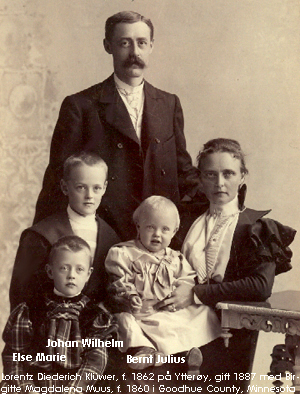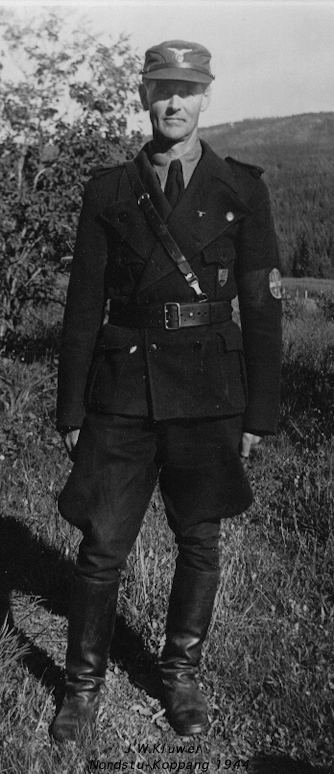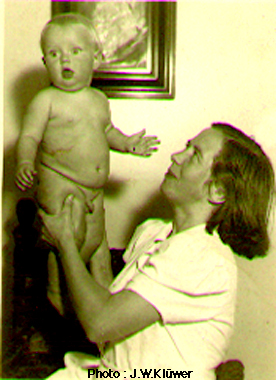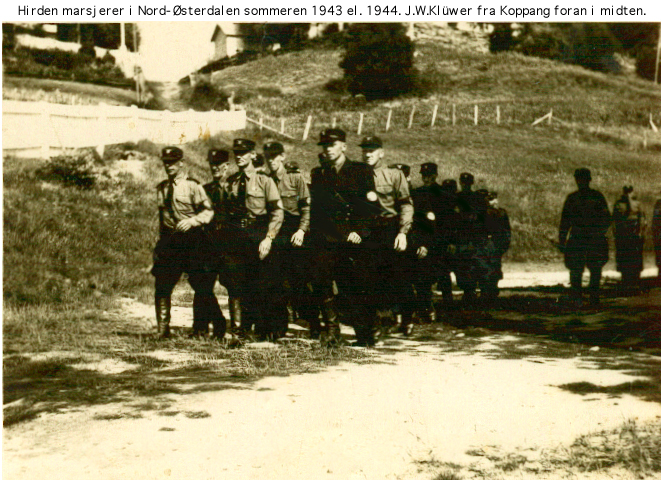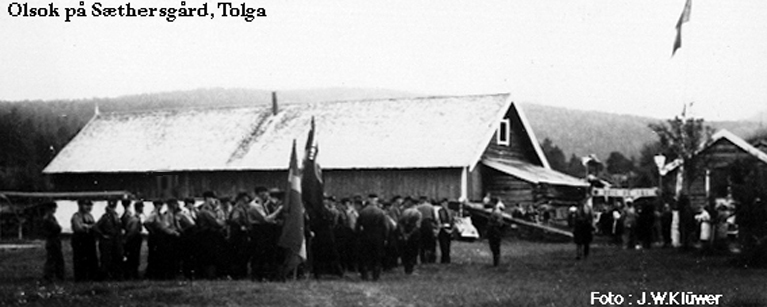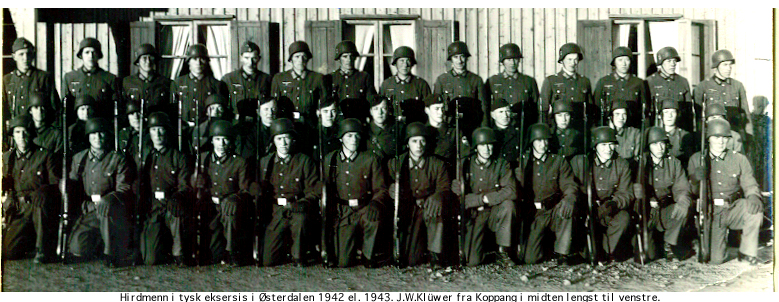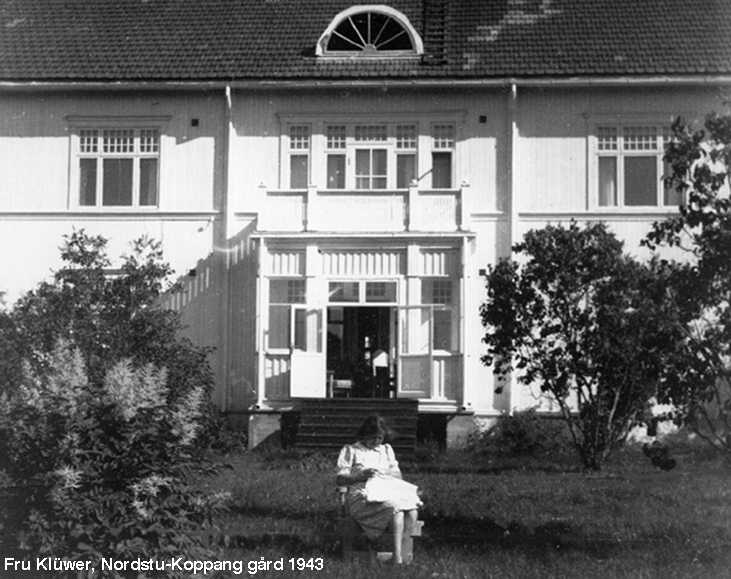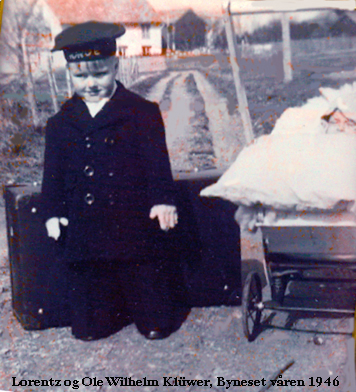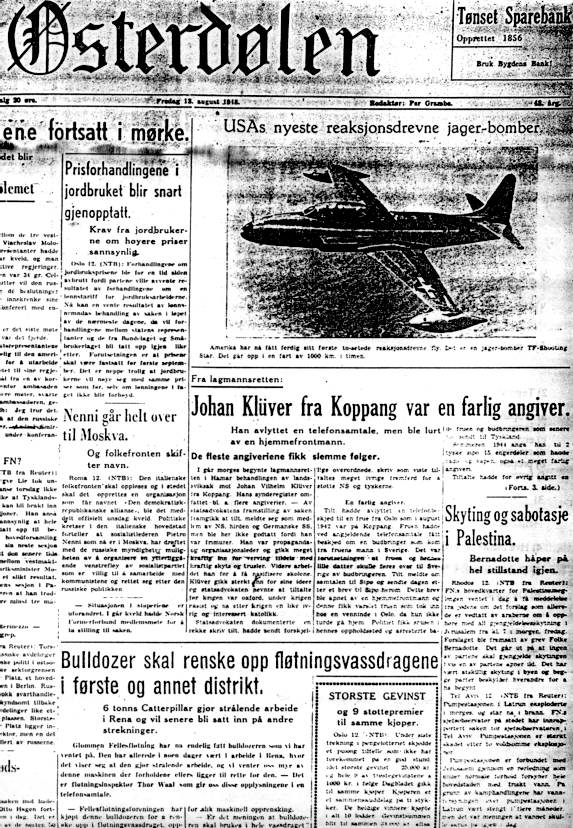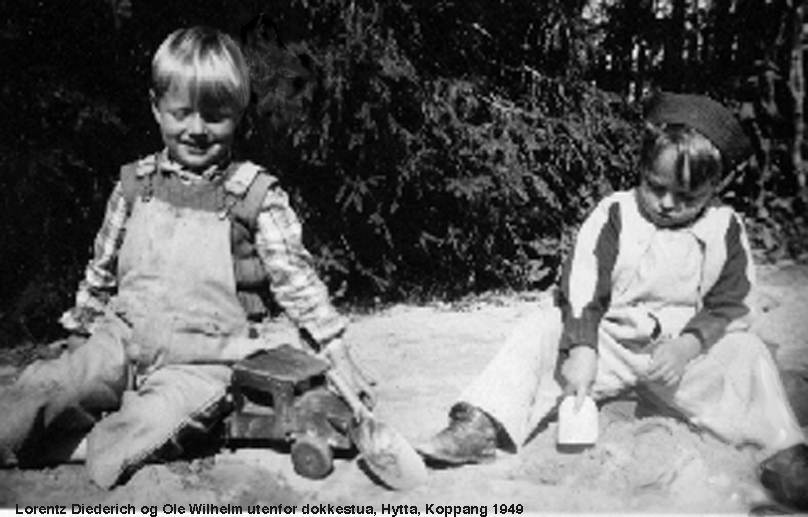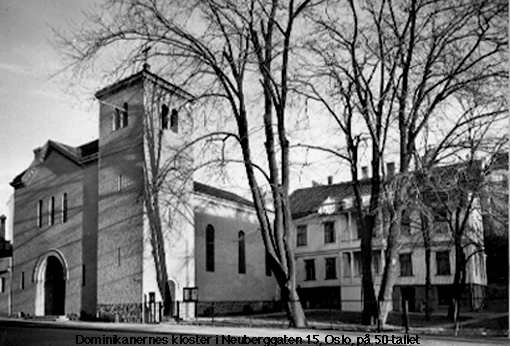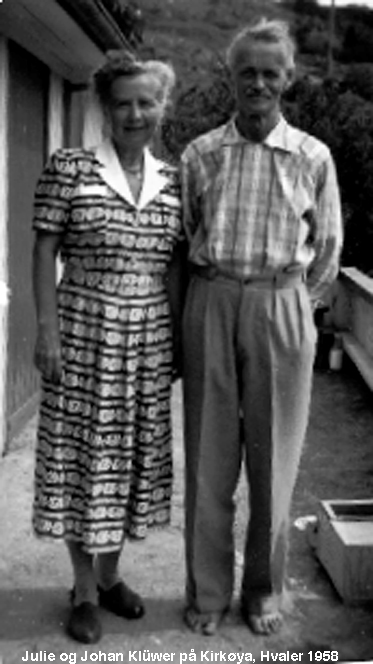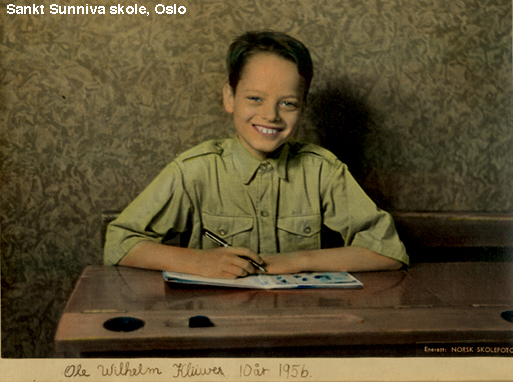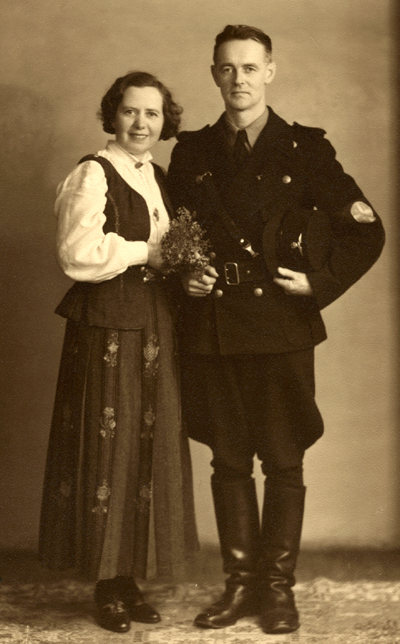
Orkanger 1906, marry the 27th of February 1943. They have met
within Party circles in Oslo where both are active, he as a
hirdman, during periods guarding Quisling's office at the Palace, she
as an NS propaganda leader among the poor house servants in Oslo and
a member of the NS Chorus.
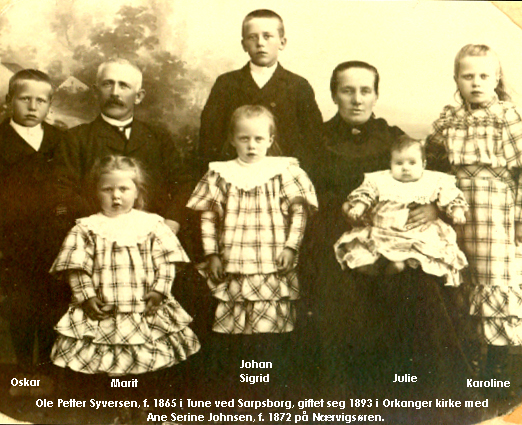 Julie, sitting on her mother's lap, regards the world of her first year 1906, being Norway's first year of independence since 1389. Nationalistic enthusiasm sweeps naturally over the country. Her parents are of modest social origin. Her father is an inspector at the sawmill, the biggest employer of Orkanger, the small town in the southern end of the fiord of Trondheim. He experiments to improve the quality of the grindstones used to sharpen saws, by burning the stones in the pottery workshop belonging to Mr. Johan Johnsen born 1826, his father-in-law. The parents' dream is to start a business for themselves, and thereby attain financial freedom. Mr. Syversen christens his small grindstone factory "Ørnen" - the Eagle. When Thams Bruk establishes partnership with a sawmill in Dubrovka east of Leningrad, Ørnen secures large orders from Russia. The Revolution of 1917 leads to bankruptcy for Julie's father. The family's impression of Communism is definitely not ameliorated. One of Julie's brothers is also going to join the NS. Julie's parents die in 1937 and 1938.
Julie, sitting on her mother's lap, regards the world of her first year 1906, being Norway's first year of independence since 1389. Nationalistic enthusiasm sweeps naturally over the country. Her parents are of modest social origin. Her father is an inspector at the sawmill, the biggest employer of Orkanger, the small town in the southern end of the fiord of Trondheim. He experiments to improve the quality of the grindstones used to sharpen saws, by burning the stones in the pottery workshop belonging to Mr. Johan Johnsen born 1826, his father-in-law. The parents' dream is to start a business for themselves, and thereby attain financial freedom. Mr. Syversen christens his small grindstone factory "Ørnen" - the Eagle. When Thams Bruk establishes partnership with a sawmill in Dubrovka east of Leningrad, Ørnen secures large orders from Russia. The Revolution of 1917 leads to bankruptcy for Julie's father. The family's impression of Communism is definitely not ameliorated. One of Julie's brothers is also going to join the NS. Julie's parents die in 1937 and 1938.
Johan Wilhelm, the eldest of three siblings, is eight on the photo taken in 1898 in Trondheim. His father Lorentz Diederich Klüwer married Birgithe Magdalena Muus in 1887, both from wealthy families in the district of Nord-Trøndelag. Lorentz follows his father's interests for business, a break in the family's military traditions which during 300 years in Norway had produced dozens of officers. The family is originally from Saxony, Germany, became knights under the Teutonic Order in the Middle Ages, migrated East and settled in Kurland. The first Klüwer arrived Norway in 1670. Johan Wilhelm's mother is of a family of priests. Her father Bernt Julius Muus was ordained as a bishop in 1858 to work for the Norwegian emigrants in USA. In Goodhue county, Minnesota, he founded the still existing Saint Olaf College. Johan Wilhelm's mother, born in Town of Wanamingo, is an American citizen, as was her mother Oline Christine Kathrine Muus, née Pind, a talented pianist. What in his family complexion pushes Johan Wilhelm toward Nazism ? Nostalgia for military carreer ? A feeling of duty toward Christianity in a century when Marxism threatens all spiritual life ? During the bishop's last years spent in Norway, Johan Wilhelm is his dearest grandson. Bernt Julius, his younger brother born 1897, also becomes sympathetic to the Nazi cause. Bernt Julius is a renowned painter when he dies in 1941, at the young age of 44. A mural is to be painted over in 1945 as the winners' posthumous castigation of a Nazi artist. Mother dies in 1935, father in 1938.
 The husband and wife always explained to their children that their
The husband and wife always explained to their children that their
wedding party excluded family members because of their age, he 53 and
she 37. An other explanation is the growing political family conflicts,
accelerating after the defeat of Stalingrad. Three days before their wedding
Johan writes to Julie : "Don't think about the talks among our friends
of taking poison in the case we lose the war. It's propaganda from
the government in London."
Hirdman Klüwer in the garden of his farm
Nordstu-Koppang, in the valley of Østerdalen,
Eastern Norway, 1944. He has joined the
NS Party in 1935, back after ten years
as a businessman in Manchuria. In China
he mainly had friends among the Russian
White refugees. They gave him horrifying
acounts of the Red Army's advance and
human practice. The Bolshevist Revolution
of 1917 shook like an earthquake Europe's
traditionalist families.
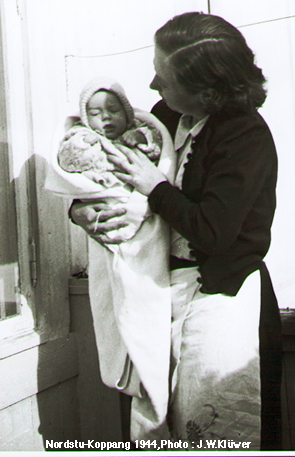 The NS parents get their first baby, a son, January 1944.
The NS parents get their first baby, a son, January 1944.
The mother expresses joy and proudness. Here she
is at the veranda of the main building of the farm
Nordstu-Koppang. The mother is a child adoring
woman. She is also an activist in an intense
campaign to win the ongoing war. At times she
gives propaganda lectures at three different
NS meetings a day.
In the living room of the farm, 3rd of November 1944.
Julie has always dreamed of an education to become a midwife.
The bankeruptcy of her father's family firm in the 20s stopped
her plans. Until the war she worked in several homes as a poor
house servant. When she joines the NS in 1940, she becomes the
spokesman of the house servants in the municipality of Oslo in
order to improve their working and living conditions.
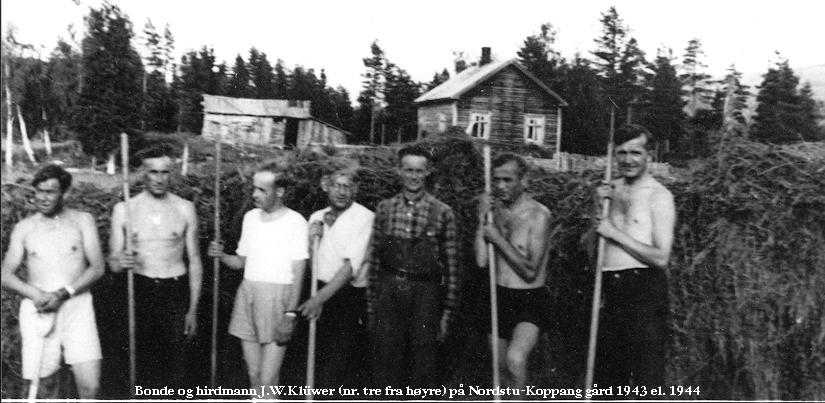 Farmer Klüwer, nr. 3 from the right, with his men during hay-making.
Farmer Klüwer, nr. 3 from the right, with his men during hay-making.
Asbjørn Østhagen, the third from the left, joines the liberation forces,
runs into the farm with his men equipped with stenguns the early morning
8th of May 1945 to arrest the NS farmer. Next day he returns to beg
Mrs. Klüwer's pardon. The Øshagens and Klüwers remain friends
the rest of their lives.
The farm Nordstu-Koppang.
After suffering from the wet climate in Manchuria, Klüwer bought in 1935 a farm in a dry area of Norway, in Østerdalen. A farm is an ideal home for an NS man - politically, culturally and curatively. Klüwer's friend Erling H. Samuelsen, to whom Klüwer's father had given shares in the family ship company, is enthusiastic about the idea of investing in the countryside. With Klüwer's farm concessions Samuelsen buys huge forested areas, transforming the farm to one of the largest of the district. Klüwer made friends with Samuelsen in London in 1913 while apprentice in the ship company Furness. Klüwer was 23 and Samuelsen 21. Back in Oslo in 1915 Klüwer asked his father to give Samuelsen access to the company. His father changed the company name from Klüwer & Søn to Klüwer & Co. In the pre-war years they had the same political evolution. Samuelsen was a contributor to "Tidens Tegn", the big Norwegian Fascist newspaper. He was also married to a NS Party member, Edith Muskulus, who wrote articles for "Heim og Ætt", an NS magazine. In 1939 Samuelsen asked Klüwer to transfer pro forma - no signed contract exists - the ownership of the farm to himself, due to some old demands from Tønsberg Bank, as he said. He wanted to help Klüwer, as he said. With the victory of the Allied Samuelsen shall take the farm. The bank shall later attest that it had no demands. Samuelsen was a typical weathercock regarding the opportunities in business and war. He had a lot to hide and demonized Klüwer when victory was assured. He had to appear as a long-time anti-Nazi. In the future Klüwer's children shall expect Samuelsen taking their father's shoe repairing equipment. The children shall often listen to mother recite the story of Samuelsen's hired man Terje who travelled up from Oslo to liquidate father in the spring of 1945 but resigned from the execution for conscience reasons, of how mother met with him and thanked him. Mother quotes Terje's reaction : "Has the housekeeper Mrs. Strand sniched on me ?" Mr. Erling H. Samuelsen shall become a friend of King Haakon VII and of Crown prince Olav, later King Olav V. His first supertanker shall be baptized with the name "Carl Joachim Hambro" after the President of the Norwegian Storting who in 1940 organized the escape of the royal family to London. A novel may be titled "Businesses, Politics and Friendship".
 The German occupation forces establish a listening-post at
The German occupation forces establish a listening-post at
the farm to detect enemy aircrafts coming through the valley.
The farm offers a panoramic view. Germans occupy
the ground floor and the Klüwers must move upstairs.
The Germans fly the swastika flag every morning. Mr. Klüwer
shares both international and social opinions with the German
National Socialists. He establishes close friendships. Ernst
Höhler, the soldier on this photo taken the 6th of January 1944,
seems to live like a tourist at the farm.
The word "hird" was used in Norway during the Middle
Ages designating the King's personal guard. The NS re-
introduced the word in the 30s for a uniformed vigilant
force serving and training throughout the country. Unlike
the German Schutz-Staffel they are normally unarmed. Militarist
Socialism brings militarist Traditionalism. Klüwer is
marching in the middle of the first row.
 Ivar Sæter, the owner of the farm Sætersgård, is a poet.
Ivar Sæter, the owner of the farm Sætersgård, is a poet.
Due to his friendship with the Party organizers, to his reputation
as an artist, to his farm's history and old buildings, the NS
organizes Olsok meetings at the farm. Olsok, the 29th of July,
is the memorial day of Saint Olaf, the King of the vikings. The
buildings form a square where the enthusiastic participators gather.
Quisling gives his speech from the balcony of an old storehouse.
The last decade it has been hard to meet anybody who remembers
the great celebrations. The former proud Norwegians have chosen
to forget.
Sætersgård, Tolga.
The village Tolga has the highest concentration
of NS members and supporters in Norway. Over
the entrance on the right hand side is written as a
welcome "Heil og Sæl", the NS greeting words.
"Heil og Sæl" is an archaic Norwegian form of
greeting and means "Be sound and happy".
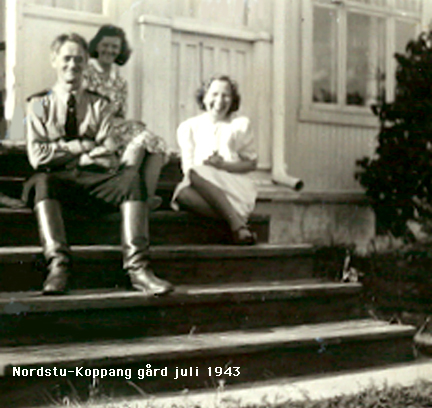 Mr. and Mrs. Klüwer in 1943.
Mr. and Mrs. Klüwer in 1943.
In the middle Kari Olsen, Julie's girlfriend from her childhood
days in Orkanger. Kari who works as a house servant, like
Julie did before her marriage, does not become an NS member.
Kari breaks all contact with her girlfriend after the defeat.
In the 70s they get close again.
Beside his doubts about Capitalism and Communism, Klüwer
spreads in the valley the forgotten practice of sauna and
the old Norwegian race of sheep, spærsau.
Klüwer undertakes German soldier training. He sits
in the middle row to the left. Like younger Norwegians
he volunteers for combatting the Bolshevists at the
Eastern front. He applies for Den Norske Legion, is
rejected because of his age. He applies for the Wiking
Division, is rejected again. The Germans want him to
stay at the farm. Altogether 6000 Norwegians are to
fight in the Soviet Union after having sworn
their loyalty to Hitler as commander. 700 die.
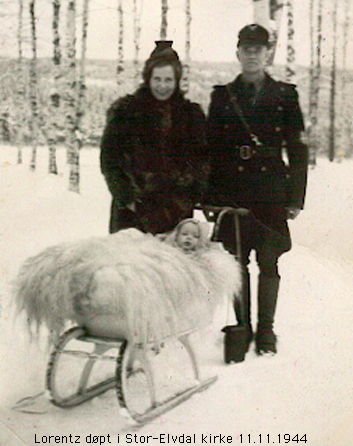 Lorentz is baptized in the Protestant church of Stor-Elvdal
Lorentz is baptized in the Protestant church of Stor-Elvdal
the 11th of February 1944.
The first born son is treated
like a prince. At this time, while thinking of her son, the
mother writes a necrology for the young friend Nils Strand,
a Norwegian SS soldier fallen on the front of Leningrad. The
article is printed in the NS Party's newspaper Fritt Folk.
Julie
in the garden
of the farm,
illuminated
by the war days'
mythical
light.
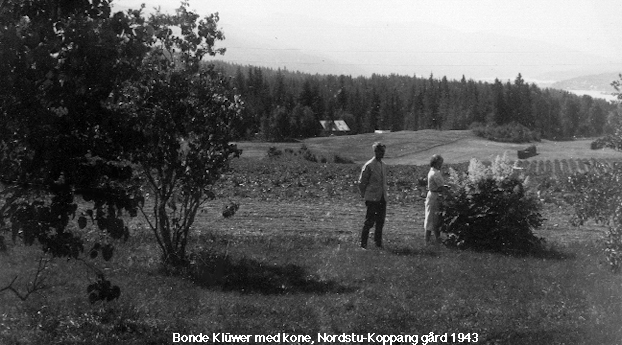 The Klüwers' happiness is frozen in a war summer. The couple
The Klüwers' happiness is frozen in a war summer. The couple
moves in a dream garden. What are their dreams ? Which are
their plans for the children ? Who are they before the defeat ?
An NS child from the district, born early in the 30s, recently said that
Klüwer was a talkative humorist who easily addressed all kinds of
persons, just like this NS child's own father. The younger children never
met their fathers like that. Many NS members suffered a transformation
of their personality with the defeat. They would prefere silence, their eyes
lost their former glaze, even their voices changed. The children born too
late to have memories from their parents' energetic years, try to imagine
their pre-defeat reality. Like another NS child says, born 1944 : "I have always tried to find on my fathers face the smile he had on a photo from the war".
Byneset, close to Trondhjem 1946.
The pregnant mother and Lorentz, aged one and a half, were thrown out of
their farm in May 1945, two weeks after the father had been arrested. He is in prison,
for an unknown destiny. He is not to be judged before August 1948, then getting
nine years of forced labor. The younger NS-children start to get their first memories.
In the Spring 1946, a few months after the second son Ole Wilhelm is born, the family
is once again thrown out, this time from an apartment rented by an aunt.The mother
had felt secure close to a sister. The owner, the director of a stove factory, got reports
that he was housing a Nazi family. The big trunc is symbolic of their endless travels
while the father is in prison and contact with him is prohibited.
 Steinkjer churchyard 1947. Always on the
Steinkjer churchyard 1947. Always on the
road,
chased by the Norwegian winners
wherever she searches a place to live,
the mother brings her children to the family grave.
Does she dream of assistance from the dead ?
Lorentz is always wearing a correct cap to disguise
the family's identity.
The majestic river Glomma runs through the valley
of Østerdalen. The children hear later their mother's
story when she, taken by despair, brought them
down to the river for a water journey to eternity.
Front-page of the local newspaper Østerdølen the 13th of August 1948.
Every day after the defeat, year after year, the newspapers expose the
lives of the losers, write criminal reports like entertainment for the winners,
depict our fathers' moral decay, their endless evil atrocities. Our fathers
are all traitors, renegades, worse than common criminals. Every day is a
threat for those of our mothers who live outside the prisons : when is their
husband's name going to fill the newspapers and their new homes discreetly
rebuilt going to be destroyed ? The newspapers are a source of depressions.
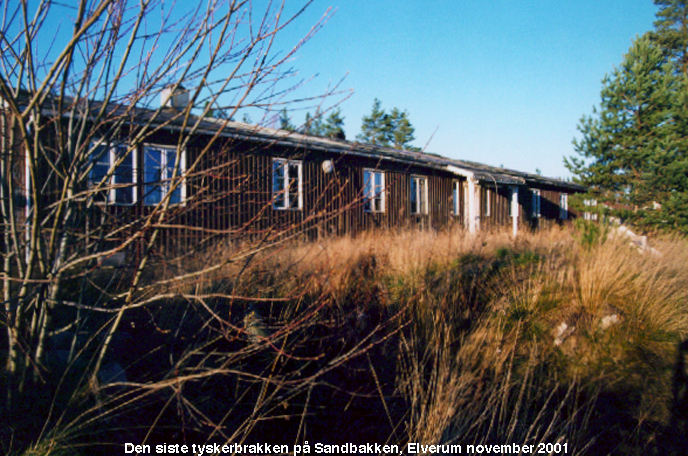 The barracks of Sandbakken in Elverum are ordered by the Germans.
The barracks of Sandbakken in Elverum are ordered by the Germans.
There are four of them, at the end of the war filled with Soviet prisoners.
Each would lodge 150 persons. After the war the camp houses the traitors
to be punished, becomes the de-nazification center for most of the NS
members sent there from all Østerdalen. Klüwer stays three years at
Sandbakken. After his conviction August 1948 he is transfered to the
camp Gulskogen close to Drammen. The photo is taken days before the last
barrack is demolished November 2001.
The Nazi children are playing in the backyard
of their small new home, by people called the
doll house. The family is back in Koppang,
living downhill from the taken farm. Two old
sisters let them rent the doll house on their
ground. The toy lorry maid by the Nazi
prisoners of Sandbakken, Elverum, was a Christmas gift from the father.
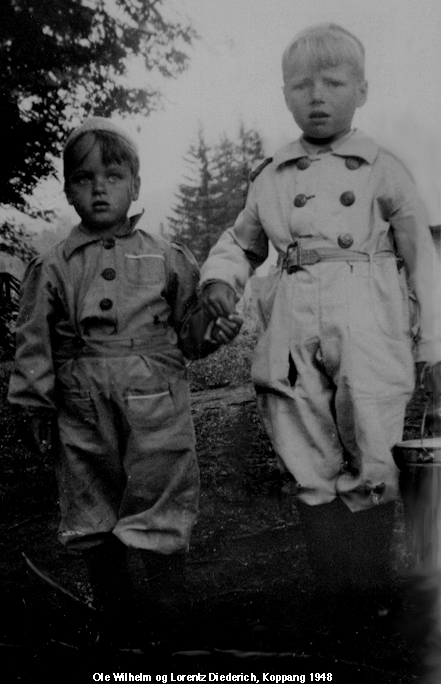 The seriousness or even fear of the faces is due to the
The seriousness or even fear of the faces is due to the
1949 day's mission : Go uphill to the farm and ask the occupiers
for mother's sewing machine. On the way back they shall bring
milk from a neighbour farm. The mother thinks that her sons
are going to succeed because of their age. Every of her
own attempts to get any belongings out from the farm has been vain.
The boys know that they are to be harshly reproved and
rejected by the usurpers as Nazi children; they have tried before.
The sewing machine is not going to be delivered, nor is the farm.
Some Nazi children have said they didn't know about their fathers'
incarceration. One of the Klüwer children's first memories is the
kneeling before the bed every evening, praying to God that father
shall get safe out of the prison.

The father is too sick to participate in the celebrations of the
Constitution Day, a roaring festivity for the war winners.
He was sick when he got out of the prison some months earlier.
He then weighed 38 kilos.The celebrations are not helping him to a
better mood. A woman, a mother, has a stronger survival instinct.
She is thinking of her children, of their future. All family initiatives must
be balanced with the demands of the new society. The family gets
two realities. The mother disguises her children like dwarf marins,
like winners. The schizofrenic life of the NS children begins.
The mother has no ideas of the future mental harm she causes.
Should the mother and children rather have worn the losers' symbols in
order to let themselves be beaten up ? The postwar pacification,
the de-nazification program of the Allies and the Communists which
is nothing but satanization, makes quickly young victims.
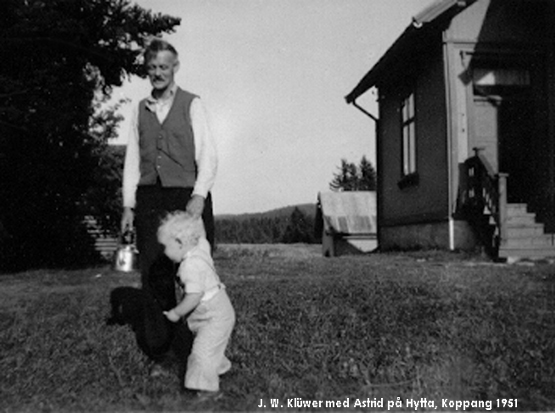 After his years in prison Klüwer appears
After his years in prison Klüwer appears
in 1951 for the first time on a photo.
He is now a war criminal, traitor and
shoemaker, shunned by the good Norwegians,
feared by many in the family because he is
a source for shame. Klüwer is handling
the coffeekettle and the daughter of the
neighbour who shot the picture. Probably
to express his grief, Klüwer hangs black
crosses of wood on all the house walls.
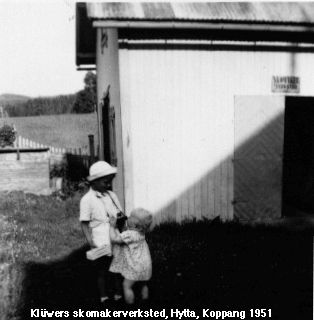 In the background are the
In the background are the
fields which once belonged
to Klüwer. The usurpers of the
farm, uphills toward the left,
offer now parties in honour of
the heroes who for business
reasons lived in New York or
London during the war. Klüwer
tries to make a living as a shoe-
maker. A signboard of the work-
shop is seen on the photo.
Who wants shoes repaired
by a Nazi ?
Klüwer earns 18 Norwegian crowners a month. In 1953
the family is forced to leave the community Stor-Elvdal.
In prison Klüwer has become a Catholic. Protestant priests
refused to enter the camps for the Nazis. The bishop of Oslo
Eivind Berggrav proclamed the prisoners as being the
Devil's children. The Catholic priests went in, gave the
prisoners spiritual consolation, father Thorn in the district
of Oslo, father Parthe in Eastern Norway. Prior Lutz of the
convent of the Dominicans in Oslo welcomes the family.
They get a flat on the top of the house, Johan working as
caretaker and Julie as cook. The photo of the convent in
Oslo is from the 60s.
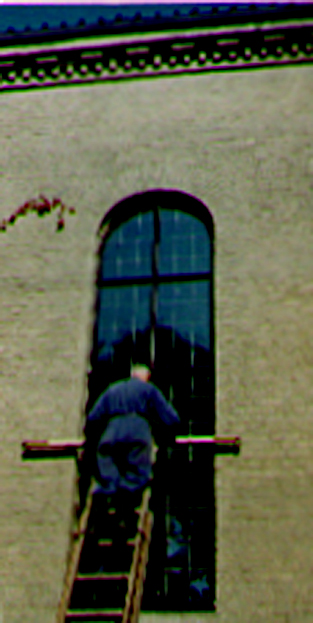 Klüwer has undertaken a new ascension.
Klüwer has undertaken a new ascension.
A remarkable number of the Nazis convert
to the Catholisism. What do they want ?
What do they expect ? Klüwer's children
get free entrance to St. Sunniva, the Catholic
school of Oslo, which several NS children
are going to attend. Within two decades
the Church is going to deny its own history.
The photo is taken in the late 60s.
A summer day 1958 one of the sons asks his mother wether it's true
that a Danish woman married to a Klüwer in the 18th century was of
Jewish descent. The mother answers :"If I had known that was true,
I would never have married your father". Mr. and Mrs. Klüwer have
a strong feeling of the purity of their race. The German, the Nordic
race is a value to preserve, to fight for. They are proud of Hitler who,
they say, wanted to send the Jews to Madagaskar. Peace in Europe
could only become reality if the Jews were sent out of Europe. What
about the gas chambers ? "The gas chambers are Jewish-American
propaganda inventions", is the repetitious answer.
 At the balcony on the top floor of the convent in 1956.
At the balcony on the top floor of the convent in 1956.
Lorentz and Ole Wilhelm are together with a schoolmate from
St. Sunniva. They have an apparently confortable life in their
new surroundings. With the accelerating attention on the Nazis'
cruelties through books, films, radio and newspapers, their
inner lives are getting more and more tortured. The paroxysm
is reached with the launching of the Holocaust topic in 1961/
1962. The children feel that they are of evil blood. The sataniz-
ation hits every Nazi child in Europe. Mr. and Mrs. Klüwer die
in 1985 and 86. They are going to keep their National Socialist
ideals to their end, regularly attending the meetings of their Organization INO.
Most Nazi children are tortured by the accelerating denazification practice in the schools. Heroic stories of Nazi Resistants are methodically read by the teachers for entertainment in the classes. Every Nazi depicted is imbecile and monstrously evil. In 1956 the satanization has not yet reached the Catholic school in Oslo. The elderly German and French nuns who are the teachers, sympathizers of old day's social life, avoid commenting the war in the classes. The smile of the Nazi boy is an evidence. He is wearing the shirt of Guttehirden, the NS Youth Movement, inherited from a Nazi family with older kids. The shirt has been stripped of all compromizing signs, though.
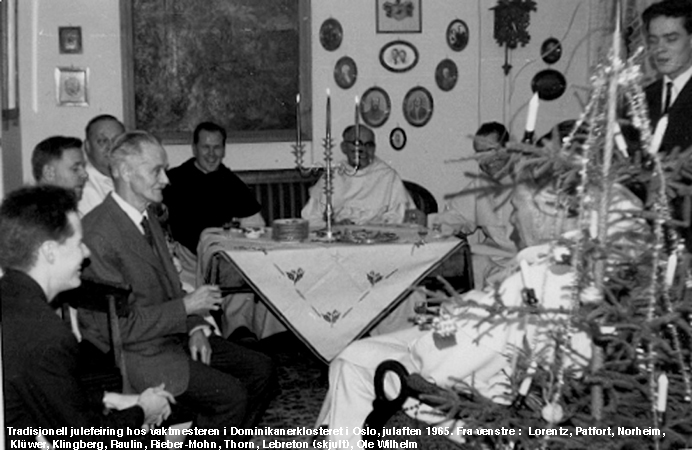 Party in the convent, Christmas Eve 1965.
Party in the convent, Christmas Eve 1965.
The Dominicans have, each Christmas, cakes,
cofee and some brandy in the caretaker's flat
after the 5 o'clock celebration in the church for
the small kids of the parish. As small, the
Klüwer boys were always ministrants.
The conversation is open. The Nazi newspaper
"Folk og Land" is to be found on every
small table. The parents dominate their life,
unlike the boys who slowly get eaten
by the Holocaust, by the feeling of
guilt.
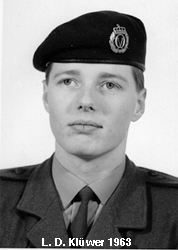
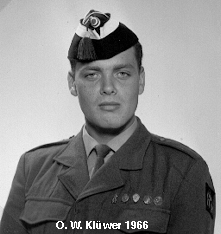 Nazi children in the uniform of the enemy.
Nazi children in the uniform of the enemy.
As long as the Allies' denazification plan is still in vigour and the winners ignore the present and the future status of the European Nazi children, the social contract between the Europeans is broken. No democratic ideals can hide the mental misery left after the world's most violent war. No humanistic academy nor social philosophy, even based on human rights traditions, can be taken seriously as long as they neglect this mental catastrophy. When are the winners going to undertake an attempt for a reconciliation ?
The two Nazi children in uniform are not happy citizens. They have never managed to feel being citizens of Europe. Half of the continent's inhabitants fought on the Fascist or Nazi side. Their children count millions.
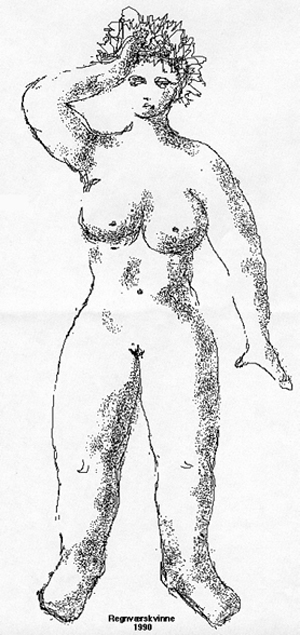
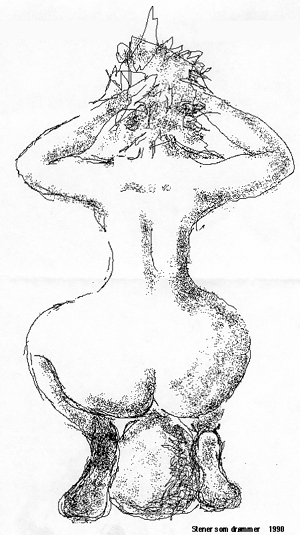 Love - the most meaningful word for life on earth. How can Nazi children love ? Beside erotic activities, individually based and free of responsability, can the Nazi children love on a broader base, involving history conscience, self-confidence, social care ? In the 90s the German TV serie "Heimat" by Edgar Reitz had success, the story of a German familiy through three generations in the 20th century. The sad part were the love stories of the post-war generation. A man's suicide in a lake by dawn was significant. To be the children of the celebrated worst criminals, the unique non-humans of History, has to give sentimental consequences.
Love - the most meaningful word for life on earth. How can Nazi children love ? Beside erotic activities, individually based and free of responsability, can the Nazi children love on a broader base, involving history conscience, self-confidence, social care ? In the 90s the German TV serie "Heimat" by Edgar Reitz had success, the story of a German familiy through three generations in the 20th century. The sad part were the love stories of the post-war generation. A man's suicide in a lake by dawn was significant. To be the children of the celebrated worst criminals, the unique non-humans of History, has to give sentimental consequences.
How can love be restored in the war damaged hearts of millions of Europeans ? Is there any other way than the one which goes through a European reconciliation ? Nazi children being parents - can they, with their wounded hearts, passe love to their own children ? Testimonies of sentimental complications from the 3rd generation will soon come. They'll have to rebuild the bridge between the generations, just like the 2nd generation tries to heal their generational gap. Love is demanding power. How come that the best traditional love story in Norway after the war is written by a Nazi child ? (Eystein Eggen : "Hov", 1997.)
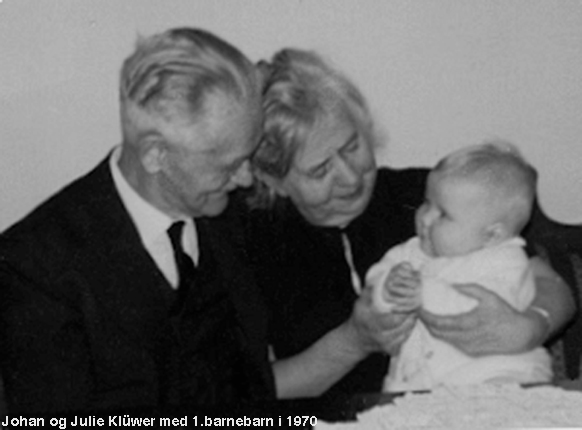
Does the history belong to everybody, including the losers ?
Does the history belong to our coming generations ?
Who are the losers of the necessarily coming conflicts in our world ?
The photo shows Mr. and Mrs. Klüwer with their first grandson in 1970.
